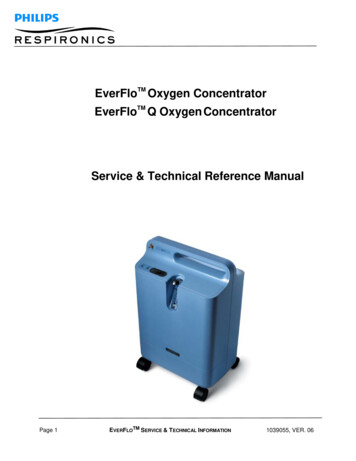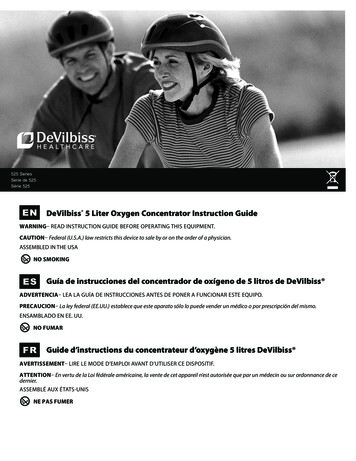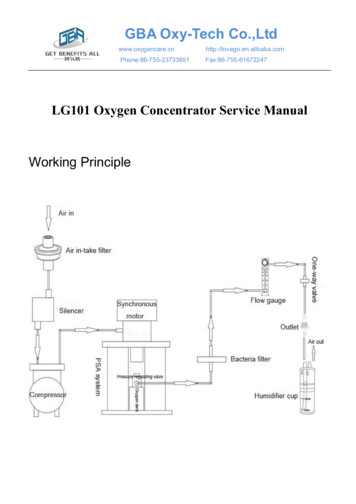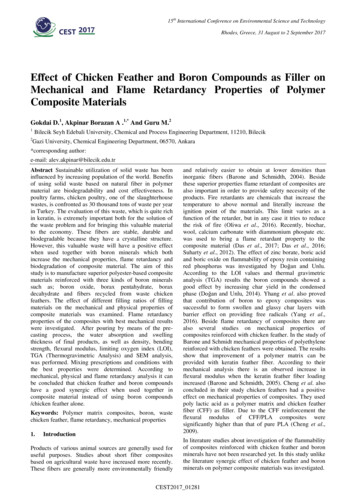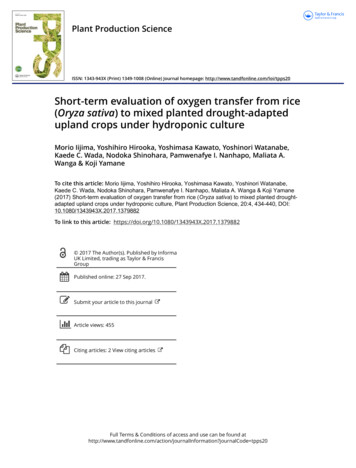
Transcription
Plant Production ScienceISSN: 1343-943X (Print) 1349-1008 (Online) Journal homepage: http://www.tandfonline.com/loi/tpps20Short-term evaluation of oxygen transfer from rice(Oryza sativa) to mixed planted drought-adaptedupland crops under hydroponic cultureMorio Iijima, Yoshihiro Hirooka, Yoshimasa Kawato, Yoshinori Watanabe,Kaede C. Wada, Nodoka Shinohara, Pamwenafye I. Nanhapo, Maliata A.Wanga & Koji YamaneTo cite this article: Morio Iijima, Yoshihiro Hirooka, Yoshimasa Kawato, Yoshinori Watanabe,Kaede C. Wada, Nodoka Shinohara, Pamwenafye I. Nanhapo, Maliata A. Wanga & Koji Yamane(2017) Short-term evaluation of oxygen transfer from rice (Oryza sativa) to mixed planted droughtadapted upland crops under hydroponic culture, Plant Production Science, 20:4, 434-440, DOI:10.1080/1343943X.2017.1379882To link to this article: https://doi.org/10.1080/1343943X.2017.1379882 2017 The Author(s). Published by InformaUK Limited, trading as Taylor & FrancisGroupPublished online: 27 Sep 2017.Submit your article to this journalArticle views: 455Citing articles: 2 View citing articlesFull Terms & Conditions of access and use can be found tion?journalCode tpps20
Plant Production Science, 2017VOL. 20, NO. 4, 9882OPEN ACCESSREGULAR PAPERShort-term evaluation of oxygen transfer from rice (Oryza sativa) to mixedplanted drought-adapted upland crops under hydroponic cultureMorio Iijimaa,b, Yoshihiro Hirookaa, Yoshimasa Kawatoa, Yoshinori Watanabea, Kaede C. Wadaa, Nodoka Shinoharaa,Pamwenafye I. Nanhapoa,c, Maliata A. Wangaa,d and Koji YamaneaaGraduate School of Agricultural Sciences, Kindai University, Nara, Japan; bJST/JICA, SATREPS, Tokyo, Japan; cFaculty of Agriculture and NaturalResources, University of Namibia, Oshakati, Namibia; dDirectorate of Research and Training, Ministry of Agriculture, Water and Forestry, Windhoek,NamibiaABSTRACTMixed cropping is a cultivation method widely practiced in tropical regions. The newly developedclose mixed planting technique mitigates the flood stress of drought-adapted upland cereal speciesby co-growing rice (Oryza sativa) plants under field flood conditions. We tested the hypothesis that O2was transferred from rice to upland crops using the model system of hydroponic culture. To confirmthe hypothesis, the phenomena of O2 absorption and release by plants were evaluated in a waterculture condition without soil. Experiments were conducted in a climate chamber to estimate theamount of O2 released from the roots of rice and pearl millet (Pennisetum glaucum) under both O2rich (20.0 .0% conc. in phase I) and O2-free dark (.8 .0% conc. in phase II) conditions. The total O2change (between the two phases) in a single planting of rice and pearl millet was significantly higherthan that of the mixed planting of rice and pearl millet, which indicated that O2 was transferredfrom rice to pearl millet under a water culture condition. The result indicated that approximately7 μM O2 g fresh root weight 1 h 1 was transferred between the two plant species. O2 transfer wasconfirmed between the two plant species in a mix cultured in water, implying its contribution to thephenomenon that improved the physiological status of drought-adapted upland crops under fieldflood conditions.IntroductionMixed cropping is a major cultivation technique that isused to grow two or more plant species in the same fieldin the same year, and it is widely practiced in tropicalregions (Ramert et al., 2002; Vandermeer, 1989). Althoughmixed cropping generally induces competition for light,moisture, and nutrients among the co-growing plants(Lithourgidis et al., 2011), it is a risk management practice against crop losses (Brooker et al., 2015; Wolfe, 2000).Moreover, it often exhibits compensatory interactions suchas the supply of nitrogen nutrition from legumes to non- leguminous crops (Ehrmann & Ritz, 2014; Ramirez-Garciaet al., 2015). Close mixed planting is a newly proposedmixed cropping technique that enhances the flood stresstolerance of co-growing drought-adapted upland cerealcrops (Awala et al., 2016; Iijima et al., 2016). Growing floodand drought-adapted crops at the same time in the samefield, as in close mixed planting, will be a new global challenge to overcome the effects of climate change. For example, close mixed planting with rice (Oryza sativa) improvedCONTACT Morio IijimaARTICLE HISTORYReceived 26 May 2017Revised 14 August 2017Accepted 1 September 2017KEYWORDSClose mixed planting;flooding; oxygen release;oxygen transfer; rice; pearlmilletCLASSIFICATIONCrop Physiologythe photosynthetic rate, transpiration rate, and biomass ofco-growing upland crops grown under O2-deficient solution culture conditions. In addition, the O2 concentrationin the solution culture of upland crops was significantlyincreased by co-growing rice (Iijima et al., 2016). Even infield conditions, close mixed planting with rice mitigatedthe flood stress of upland cereals in terms of plant survivaland grain production (Awala et al., 2016). These results suggest that the flood stress of upland crops was mitigated byutilizing rhizosphere O2 that was released from rice roots.However, the O2 transfer between different plant specieshas never been analyzed before, even though mixed cropping is widely practiced.Aerenchyma formation is poorly developed in uplandcrops, and plant survival over longer periods under floodconditions is difficult. On the other hand, flood-adaptedcereal crops such as rice have a fully developed aerenchyma, and the O2 received from the stomata of leavesand stems is transported to the roots (Armstrong, 1979).Because the barrier to radial oxygen loss (ROL) at the rootiijimamorio@nara.kindai.ac.jp 2017 The Author(s). Published by Informa UK Limited, trading as Taylor & Francis Group.This is an Open Access article distributed under the terms of the Creative Commons Attribution License (http://creativecommons.org/licenses/by/4.0/), which permits unrestricted use,distribution, and reproduction in any medium, provided the original work is properly cited.
PLANT PRODUCTION SCIENCE surface is not formed near the root apex, O2 from the shootsystem leaks into the rhizosphere (Colmer, 2003; Yamauchiet al., 2013). Oxygen release from the root apex affectssoil biological environments under field conditions. Forexample, the O2 release from rice made the rhizospherewith high specific rates of various microbial transformations under field condition (Revsbech et al., 1999). In areal rice paddy field, these microbial activities will hinderthe estimation of oxygen release from crop species, andtherefore, the measurement of O2 release will be usuallyconducted under the laboratory conditions. Exposing theaboveground part of a plant to atmospheric N2 preventsO2 transport from the atmosphere to the roots throughthe aerenchyma, generating a condition where ROL doesnot occur (Lee, 2003). Maricle and Lee (2007) applied themethod to evaluate internal O2 transport by measuring thedifference between oxygen absorption when ROL did ordid not occur. Their method enabled us to assess a possible O2 transfer phenomenon that could mitigate the floodstress of drought-adapted upland crops.The objective of this study was to confirm whether O2can be transferred from rice to upland crops through theirroots at the stage examined using the model system ofhydroponic culture. For this purpose, the experiment wasconducted in a climate chamber to estimate the amountof O2 transferred between rice and pearl millet (Pennisetumglaucum) roots. We verified the O2 transfer between riceand pearl millet at least in our experimental system basedon differences in O2 concentration between single andmixed planting measured by a fiber optic O2-sensingprobe.Exhaust tubeAirGum andparafilm sealGlass tubePlantOxygen probeTemperaturesensorSilicone lidsRootsDistilled waterAir bubblingPlastic meshPlastic spacerStirrer barFigure 1. Schematic diagram of the root chamber. For rootchamber, an air-bubbling inlet tube and an exhaust tube wereplaced to relieve the pressure during air-bubbling. The distilledwater was continuously stirred using a magnetic stirrer.435Materials and methodsRice (O. sativa cv. Nipponbare) was used as the flood tolerant crop, and it is extensively used as an experimentalmaterial in Japan. Pearl millet (P. glaucum cv. Okashana 2)was used as the drought-adapted crop, which is the recommended cultivar in semiarid southern African countries. Rice and pearl millet seeds were surface sterilizedwith 2.5% (v/v) sodium hypochlorite for 5 min and rinsedin running water for 20 min. Rice seeds were soaked indistilled water, whereas pearl millet seeds were sownon paper towels in 23 23 cm Petri dishes. Seeds werepre-germinated in a dark incubator at 30 C for 14 and 48 hfor pearl millet and rice, respectively.The O2 transfer between rice and pearl millet wasanalyzed by growing the seedlings in a nutrient solution(Miyamoto et al., 2001) without soil that might disturbroot respiration measurements. The nutrient solution contained .09 mM (NH4)2SO4, .05 mM KH2PO4, .05 mM KNO3,.03 mM K2SO4, .06 mM Ca(NO3)2, .07 mM MgSO4, .11 mMFe-EDTA, 4.6 μM H3BO3, 1.8 μM MnSO4, .3 μM ZnSO4,.3 μM CuSO4 (pH 5.5–6.0). The seedlings were grown in aplant growth room with a 28/23 C day/night temperature,a 14 h photoperiod, and a 318 2 μmol m 2 s 1 photosynthetically active radiation (PAR) on the top of the canopy. The PAR value is almost same as those in previousreports to evaluate oxygen release (root respiration) in thelaboratories for growing Phragmites australis (Armstronget al., 2000), O. sativa (Rubinigg et al., 2002), and Zizanialatifolia (Nakamura et al., 2013). Pre-germinated rice seedswere sown on a screen mesh and placed on the bottom ofeach plastic seedling tray compartment (37 37 46 mm,length width height) and then covered with a thinplastic filling to avoid seed drying and light penetrationinto the root system. They were then placed in a plasticcontainer (300 210 50 mm for 0–7 d after sowing(DAS); 410 290 60 for 7–14 DAS) filled with aerateddeionized water. The averaged day water temperaturewas 30.5 C and the night water temperature was 27.5 Cduring the plant growth period. From 5 DAS, the seedlingswere grown in the nutrient solution dissolved in deionizedwater. At 14 DAS, the seedlings were transferred to anotherplastic container (295 130 240 mm) and grown until themeasurement. The solution was renewed every 2–3 d, andthe pH was adjusted to 6.0. The 4- and 3-week-old rice andpearl millet were sampled, and their shoot bases were fixedtightly in silicon lids on top of individual root chambersmade of glass (Figure 1; 118 47 mm, height diameter) and placed inside a gas exchange chamber (Figure 2;750 450 450 mm). The root growth chamber was filledwith 150 mL of distilled water. This chamber was equippedwith a fiber optic O2-sensing probe (FireSting O2 FiberOptic O2 Meter with the OXROB3, PyroScience GmbH,
436 M. IIJIMA ET AL.N2 flowMixedRice/Pearl milletFanN2 outPearl milletRiceCO2 trap columnShadingPumpRoot chamberWatre bathWatercoolerPumpPumpMagnetic stirrerFigure 2. Schematic diagram of the gas exchange chamber. The water temperature inside the root chamber was precisely controlledusing a water bath, and the water was circulated using four mini-pumps at 4 L min 1. Air in the gas exchange chamber was mixedcontinuously by two fans.Table 1. Air temperature in a gas exchange chamber and water temperature in a root chamber.Phase ITemperature ( C)AirWaterPhase IIMaximumMinimumMeanMaximumMinimumMean32.3 .129.6 .031.9 .129.0 .032.1 .129.3 .031.6 .129.6 .131.1 .129.1 .131.3 .129.3 .1Notes: Values are means standard error.Germany) and a temperature sensor (K320, TakeyamaKagaku, Japan) which was placed at about 5 mm belowthe root system. Further, an air-bubbling inlet tube and anexhaust tube were placed to relieve the pressure duringair-bubbling. The distilled water was continuously stirredusing a magnetic stirrer. The water temperature inside theroot chamber was precisely controlled using a water bathequipped with a cooler connected to a pump (9 L min 1),and the water was circulated using four mini-pumps at4 L min 1 (Table 1). Air in the gas exchange chamber wasmixed continuously by two fans (Table 1). The CO2 concentration was monitored using a portable photosynthesisanalyzer (LCpro SD, ADC BioScientific, UK). The O2 releasefrom the plant roots was evaluated during the followingtwo continuous phases (Lee, 2003; Maricle & Lee, 2007):Phase I–Light (photosynthetically active radiation of168.9 1.6 μmol m 2 s 1) and ambient air conditions weremaintained in a normal state to allow photosynthesis for30 min. Distilled water inside the root chamber was continuously air-bubbled, starting from setting up the rootsystem until the beginning of phase I, and the dissolved O2concentration was then measured continuously for 30 min(Figure 3). In all of the measurements, phase I started at1300 h of the day. Phase II–The gas exchange chamber O2level was reduced to less than .8% by pumping N2 intothe chamber at 50 L min 1 for 10 min before the start ofphase II at 1400 h of the day (Figure 3); subsequently, theflow rate was reduced to 5 L min 1 for the entire phase.Photosynthesis was stopped by creating darkness by covering the chamber with plastic shedding (photosynthetically active radiation of .1 .0 μmol m 2 s 1), and CO2 wasremoved continuously from the column. Other conditionswere the same as in phase I. After the O2 transfer measurements, fresh weight of shoots and roots, number ofleaves, and tillering number of the plants were measured.Several investigators including Colmer et al. (1998) usedroot surface area-based concentration; however, they usedonly single root axis not whole root system for the estimation of root surface area. The majorities of studies dealingwith whole root system used root fresh/dry weight-basedconcentrations, and thus, the root surface area was notmeasured. All statistical analyses were performed usingExcel Statistics Version 2012 software (SSRI).Results and discussionO2 transfer between mixed plantsAwala et al. (2016) reported that the productivity indrought-adapted crops of close mixed planting with ricewas higher than that of normal single planting under
PLANT PRODUCTION SCIENCE flooding condition in the field experiment. The mitigationeffects of rice on flood stress for drought-adapted cropswould most probably be attributed to the relatively O2 richenvironments and/or O2 transfer when pearl millet wasclosely grown with rice (Iijima et al., 2016). To confirm thehypothesis, O2 transfer was evaluated under a water culturecondition without soil. Figure 4 illustrates the phenomenaof O2 absorption and release by plants in a water culture.O2 normal diffusion (nD) from aboveground to water, O2reverse diffusion (rD) from water to aboveground, and rootrespiration (R) are the factors that affect O2 concentrationin a water culture. In addition to these factors, O2 transfer(T) between different neighboring species can be considered to exist under mixed planting conditions. Rice rootsare known to release O2 from the shoot system via theaerenchyma (Yamauchi et al., 2013). Upland crop speciesalso release O2 (Maricle & Lee, 2007), although the amountis smaller (Figure 4, Single pearl millet) compared to rice.The O2 released from rice roots is most probably absorbedby the neighboring upland species due to their higherO2 demand caused by a lower O2 supply from shoots. O2released by pearl millet may be absorbed by rice as well.In order to accurately compare O2 absorption/releasebetween single planting and mixed planting, we combined the two single-species crops of rice and pearl millet immediately before the experiment (defined as mixedplanting in this study). The only difference between single planting and mixed planting was whether the roots ofthe two different species stayed together during the shortperiod of measurement or not. For this purpose, plantswith similar agronomical traits (fresh weight of shoot androot and the number of leaf and tiller) were selected (Table2) for both single- and mixed- planting crops. Thus, themorphological characteristics [e.g. ROL barrier formationnear the root tips (Shiono et al., 2011)] of mixed plantingshould be equivalent to those of single planting.The CO2 level was adjusted to 527 6 μmol mol 1 byusing a soda lime absorbent column at the start of phaseI (Table 3). O2 transfer between the two species can beevaluated by measuring O2 changes in the water culturewhen shoots were grown under O2-rich (20.0 .0% conc. inphase I) and O2-free dark (.8 .0% conc. in phase II) conditions (Figure 5). In phase I, the plants absorb dissolved O2 inthe water for root respiration and the roots simultaneouslyrelease O2 as normal diffusion from aboveground to waterdue to the O2-rich condition in the shoot system (Figure4). Thus, O2 changes in phase I in the cultured water canbe expressed as follows;O2 changes (phase I) nD RFigure 3. Dynamics of temperature and gas concentrations in agas exchange chamber (1) and a root chamber (2).rDrDrDrDnDTRO2 fromwaterSingle ricephase InD’TnDRootchamber(1)In phase II, the plants absorb dissolved O2 from the wateras was noted in phase I, and the shoots simultaneouslyrelease O2 as reverse diffusion from water to abovegrounddue to the O2-poor conditions in the shoot system (FigureO2 fromabove-groundR437RRRiceSingle pearl milletnD’Pearl milletMixedphase IIFigure 4. Illustration of O2 absorption and release by rice and pearl millet roots in the root chamber. The solid line and broken linerepresent the O2 movement in phase I and phase II, respectively. R, respiration; nD, normal diffusion; rD, reverse diffusion; T, transfer.
438 M. IIJIMA ET AL.Table 2. Growth traits of plants used for O2 transfer measurements.Fresh weight (g plant 1)RiceSingleMixedShoot1.40 .081.34 .08Pearl milletSingleMixed6.41 .376.30 .26Root.57 .03.57 .03nsnsLeaf no.7.6 .17.6 .1ns1.73 .131.74 .11ns9.4 .19.6 .1nsnsTiller no.2.3 .22.5 .3.0 .0.1 .1nsnsn21212121Notes: Values are means standard error. ns, no significant difference by Student’s t-test.n represents the sample size.Table 3. O2 and CO2 gas concentrations in a gas exchange chamber.Phase IStartGas concentrationO2 (%)20.0 .0CO2 (ppm)527 6Phase IIEndStartEnd20.0 .0474 16.8 .020 1.6 .011 1Notes: Values are means standard error.Phase II (-O2)O2 concentration (µM)220200180160RicePearl MilletJust-mixMixedR140120PM010Air bubbling2030where r is rice and p is pearl millet.mix O2 changes (phase I - II) nD (mix) rD (mix)(5)Phase I ( O2)240Equation (3) can be expressed by the total single plantingof rice and pearl millet (Total single) and mixed planting(Mix), respectively, as follows;Total-single-O2 changes (phase I II)(4) nD (r p) rD (r p)0102030where mix is mixed planting of rice and pearl millet.As mentioned above, in this experiment, morphologicalcharacteristics of mixed planting during the short period ofmeasurement were not quantitatively different from thatof single planting. Because the two plants were combinedjust before the experiment, rD was assumed to be the species characteristic value, and the total rD of single plantingrice and pearl millet {rD (r p)} was not different from thatof mixed planting {rD (mix)}. Therefore, (Equations (4) (5))can be expressed as follows;O2 changes (phase I - II) (Total single - mix)(6) nD (r p) nD (mix)Measuring time (min.)Figure 5. Dissolved O2 concentration of the distilled water in theroot chamber (Figure 1) where plant roots were situated (n 21)during the two 30-min consecutive phases: O2-rich light phase(Phase I) and O2-poor dark phase (Phase II) shoot environment.In order to accurately compare O2 absorption/release betweensingle and mixed, the two single plants of rice and pearl milletwere combined immediately before the experiment to measureO2 transfer.4). According to Lee (2003), the root respiration (R) duringPhase I can be assumed to be similar to that in phase II.Thus, the O2 changes in phase II in the cultured water canbe described as,O2 changes (phase II) rD R(2)nD (r p) nD (mix) T (mix)(7)Equation (7) is substituted into (6) as follows;Therefore, (Equations (1)–(2)) is,O2 changes (phase I II) nD rDSimilarly, the total amount of released O2 was also assumedto be the species characteristic value. The O2 released fromthe roots by mixed planting can be classified into twocategories: that remaining in the cultured water (residualcomponent, indicated as nD’ in Figure 4) and that transferred to different neighboring species (O2 transfer component, indicated as T in Figure 4). On the other hand, the O2released from the roots by single planting is representedonly by normal diffusion. Thus, the sum of O2 released bythe two single-species seedlings {nD (r p)} will be equivalent to the total O2 released by the mixed two seedlings{nD’ (mix) T (mix)} as follows;(3)The difference in O2 changes between phase I and phase IIindicates the sum of normal diffusion and reverse diffusion.O2 changes (phase I - II) (single total - Mix) {nD’ (mix) T (mix)} nD’ (mix) T (mix)(8)
PLANT PRODUCTION SCIENCE Rice3060PearlMilletSingleTotalMixed*Changes in O2 concentration(µM g fresh root weight 1 h 1)1020-10-20-30-60-50-100-70-140phase Iphase II-90-180phase I IIFigure 6. Changes in O2 concentration in the distilled water inthe root chamber (Figure 1) where rice and pearl millet rootsin single planting or mixed planting were situated (n 21). Anasterisk indicates a significant difference by a Student’s t-test atthe p 0.01 level. The difference between phase I and phase IIindicates the sum of diffusion (nD rD), and those betweensingle total and mixed indicates the oxygen transfer between thetwo species {T (mix)}.O2 transfer between rice and pearl millet was representedby the difference of O2 changes (phase I II) between single planting of rice and pearl millet and mixed planting.In this study, the sum of the O2 changes (phase I II) insingle planting of rice and pearl millet was significantlyhigher than that of mixed planting of rice and pearl millet(Figure 6; p .01), which indicated that O2 was transferredbetween rice and pearl millet under a water culture condition, at least in our experimental system. These results indicated that approximately 7 μM O2 g fresh root weight 1 h 1was transferred between the two plant species, and mostof them should be transferred from rice to pearl millet.Technical evaluation for O2 transferThe flood mitigation effects observed in previous studies(Awala et al., 2016; Iijima et al., 2016) for drought-adaptedupland crops could be attributed to the O2 transferredfrom the roots of flood-adapted to drought-adaptedcrops. To date, O2 release can be analyzed using severalmethods (Colmer, 2003; Wu et al., 2014). This study useda fiber optic O2-sensing probe (Maricle & Lee, 2007) tomeasure the O2 net flux from the whole root system tothe O2-rich (228 .4 μM) water environment, which hasnot been used before. So far, low O2 concentrations, i.e.15 μM (Sorrell & Armstrong, 1994), 60–70 μM (Lee, 2003),or 120 μM (Maricle & Lee, 2007), were used at the start439of the experiments; however, the root respiration rates ofthe drought-adapted upland species used in this studywere significantly reduced under such a low O2 concentration range within 30 min. Thus, estimating O2 releaseat low O2 concentrations was considerably difficult. In thisstudy, seedlings grown in the water culture without a soilmedium were used for the estimation of O2 transfer; thismight be different from the actual O2 released by a tangledroot system grown in soil. In the case of mixed planting, theroot surface sorption zone was partly disturbed by the mixing of different species, whereas that of the tangled rootsystems of the close mixed seedlings grown in soil wouldbe significantly disturbed by the mixed species duringgrowth. For example, the root hairs of epidermal cells of thetwo species may become entangled with each other andwith soil particles. Thus, the living sloughed root cap cellson the root surface during root penetration (Iijima et al.,2000, 2004) will also interact with those from the mixedneighboring species. Further study using a real soil systemis required to confirm this phenomenon in fields.AcknowledgementsWe thank the members of the projects entitled ‘Flood- andDrought-adaptive Cropping Systems to Conserve Water Environments in Semi-arid Regions’ by the framework of the ‘Science and Technology Research Partnership. We also thank allthe students of Kindai University for their assistance.Disclosure statementNo potential conflict of interest was reported by the authors.FundingThis work was supported by the Japan Science and Technology(JST) and the Japan International Cooperation Agency (JICA).ReferencesArmstrong, W. (1979). Aeration in higher plants. Advancesin Botanical Research, 7, 225–332. doi:10.1016/S00652296(08)60089-0Armstrong, W., Cousins, D., Armstrong, J., Turner, D. W., & Beckett,P. M. (2000). Oxygen distribution in wetland plant roots andpermeability barriers to gas-exchange with the rhizosphere:A microelectrode and modelling study with Phragmitesaustralis. Annals of Botany, 86, 687–703. doi:10.1006/anbo.2000.1236Awala, S. K., Yamane, K., Izumi, Y., Fujioka, Y., Watanabe, Y., Wada,K. C., Iijima, M. (2016). Field evaluation of mixed-seedlingswith rice to alleviate flood stress for semi-arid cereals.European Journal of Agronomy, 80, 105–112. doi:10.1016/j.eja.2016.07.003Brooker, R. W., Bennett, A. E., Cong, W. F., Daniell, T. J., George, T.S., Hallet, P. D., White, P. J. (2015). Improving intercropping:A synthesis of research in agronomy, plant physiology andecology. New Phytologist, 206, 107–117. doi:10.1111/nph.13132
440 M. IIJIMA ET AL.Colmer, T. D. (2003). Long-distance transport of gases in plants: Aperspective on internal aeration and radial oxygen loss fromroots. Plant Cell and Environment, 26, 17–36. doi:10.1046/j.1365-3040.2003.00846.xColmer, T. D., Gibberd, M. R., Wiengweera, A., & Tinh, T. K.(1998). The barrier to radial oxygen loss from roots of rice(Oryza sativa L.) is induced by growth in stagnant solution.Journal of Experimental Botany, 49, 1431–1436. doi:10.1093/jxb/49.325.1431Ehrmann, J., & Ritz, K. (2014). Plant: Soil interactions in temperatemulti-cropping production systems. Plant and Soil, 376, 1–29.doi:10.1007/s11104-013-1921-8Iijima, M., Awala, S. K., Watanabe, Y., Kawato, Y., Fujioka, Y.,Yamane, K., & Wada, K. C. (2016). Mixed cropping has thepotential to enhance flood tolerance of drought-adaptedgrain crops. Journal of Plant Physiology, 192, 21–25.doi:10.1016/j.jplph.2016.01.004Iijima, M., Griffiths, B., & Bengough, A. G. (2000). Sloughing ofcap cells and carbon exudation from maize seedling roots incompacted sand. New Phytolgist, 145, 477–482. doi:10.1046/j.1469-8137.2000.00595.xIijima, M., Higuchi, T., & Barlow, P. W. (2004). Contribution of rootcap mucilage and presence of an intact root cap in maize(Zea mays) to the reduction of soil mechanical impedance.Annals of Botany, 94, 473–477. doi:10.1093/aob/mch166Lee, R. W. (2003). Physiological adaptations of the invasivecordgrass Spartina anglica to reducing sediments: Rhizomemetabolic gas fluxes and enhanced O2 and H2S transport.Marine Biology, 143, 9–15. doi:10.1007/s00227-003-1054-3Lithourgidis, A. S., Dordas, C. A., Damalas, C. A., & Vlachostergios,D. N. (2011). Annual intercrops: An alternative pathway forsustainable agriculture. Australian Journal of Crop Science, 5,396–410.Maricle, B. R., & Lee, R. W. (2007). Root respiration and oxygen fluxin salt marsh grasses from different elevational zones. MarineBiology, 151, 413–423. doi:10.1007/s00227-006-0493-zMiyamoto, N., Steudle, E., Hirasawa, T., & Lafitte, R. (2001).Hydraulic conductivity of rice roots. Journal of ExperimentalBotany, 52, 1835–1846. doi:10.1093/jexbot/52.362.1835Nakamura, M., Nakamura, T., Tsuchiya, T., & Noguchi, K. (2013).Functional linkage between N acquisition strategies andaeration capacities of hydrophytes for efficient oxygenconsumption in roots. Physiologia Plantarum, 147, rt, B., Lennartsson, M., & Davies, G. (2002). The use of mixedspecies cropping to manage pests and diseases – Theoryand practice. In Proceedings of the UK Organic Research 2002Conference, Organic Centre Wales, Institute of Rural Studies,University of Wales Aberystwyth, 207–210.Ramirez-Garcia, J., Martens, H. J., Quemada, M., & ThorupKristensen, K. (2015). Intercropping effect on root growthand nitrogen uptake at different nitrogenlevels. Journal ofPlant Ecology, 8, 380–389. doi:10.1093/jpe/rtu024Revsbech, N. P., Pedersen, O., Reichardt, W., & Briones, A. (1999).Microsensor analysis of oxygen and pH in the rice rhizosphereunder field and laboratory conditions. Biology and Fertility ofSoils, 29, 379–385. doi:10.1007/s003740050568Rubinigg, M., Stulen, I., Elzenga, J. T. M., & Colmer, T. D. (2002).Spatial patterns of radial oxygen loss and nitrate netflux along adventitious roots of rice raised in aerated orstagnant solution. Functional Plant Biology, 29, 1475–1481.doi:10.1071/FP02081Shiono, K., Ogawa, S., Yamazaki, S., Isoda, H., Fujimura, T.,Nakazono, M., & Colmer, T. D. (2011). Contrasting dynamicsof radial O2-loss barrier induction and aerenchyma formationin rice roots of two lengths. Annals of Botany, 107, 89–99.doi:10.1093/aob/mcq221Sorrell, B. K., & Armstrong, W. (1994). On the difficulties ofmeasuring oxygen release by root systems of wetland plants.Journal of Ecology, 82, 177–183. doi:10.2307/2261396Vandermeer, J. (1989). The ecology of intercropping. Cambridge:Cambridge University Press.Wolfe, M. S. (2000). Crop strength through diversity. Natur
mixed cropping technique that enhances the flood stress tolerance of co-growing drought-adapted upland cereal crops (Awala et al., 2016; Iijima et al., 2016). Growing flood- and drought-adapted crops at the same time in the same field, as in close mixed planting, will be a new global chal-le
